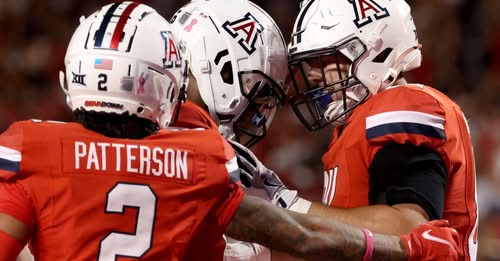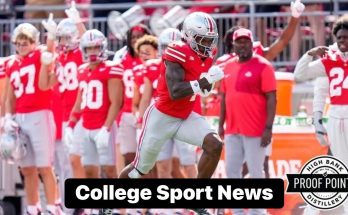The Arizona Cardinals enter the 2025 NFL season with an evolving offensive identity and renewed optimism around the passing game, largely centered on the return to full health of quarterback Kyler Murray and the influx of young talent across the roster. Among the most scrutinized and pivotal groups this year are the wide receivers and tight ends — two units that are essential for the Cardinals’ success in a division where offensive firepower is not just a luxury but a necessity.
After a 2024 season marked by growing pains, injuries, and inconsistency, the receiving corps for Arizona is at a crossroads. The team has moved away from relying solely on aging veterans and is now embracing a younger, more dynamic group of playmakers. With a mixture of explosive rookie potential and steady veteran leadership, this season’s group offers both intrigue and uncertainty. The tight ends, meanwhile, represent a key component in head coach Jonathan Gannon and offensive coordinator Drew Petzing’s balanced offensive philosophy, which emphasizes flexibility, pre-snap motion, and versatility in formation.
Leading the charge for Arizona’s wide receivers is second-year breakout candidate Marvin Harrison Jr. Drafted fourth overall in 2024, Harrison entered the league with lofty expectations and an NFL pedigree as the son of Hall of Famer Marvin Harrison. He delivered a promising rookie campaign despite operating within an offense that struggled with inconsistency due to Kyler Murray’s mid-season return from injury. In 2025, Harrison is poised to take the next step as the Cardinals’ undisputed WR1. At 6’4″ with elite route-running ability, soft hands, and an innate understanding of leverage, Harrison has all the tools to be a dominant force. His ability to stretch the field vertically while also being reliable in the intermediate and red zone areas gives Arizona a true game-changer at the position — something the team hasn’t consistently had since the prime of Larry Fitzgerald.
Harrison’s presence should also unlock opportunities for the rest of the receiving corps. Michael Wilson, entering his third year, is one of the most overlooked pieces of this offense. Wilson has flashed at times, showcasing good size, body control, and toughness in contested catch situations. However, he has yet to deliver a fully healthy, productive season. If he can stay on the field and develop further chemistry with Murray, he could carve out a valuable role as a possession receiver and red zone threat. His blocking ability also adds to his value, especially in an offense that aims to utilize play-action and zone-based running concepts.
The wildcard among the receivers is rookie wideout Tez Johnson, the electrifying playmaker out of Oregon. Drafted in the third round of the 2025 NFL Draft, Johnson brings a completely different skillset to the table. At just 5’10” and 170 pounds, he isn’t going to outmuscle defensive backs, but his speed, quick-twitch agility, and yards-after-catch ability make him a candidate to fill a gadget or slot role early in his career. Think of Johnson as a player who can be moved around pre-snap to exploit mismatches, line up in motion, or take jet sweeps and quick screens. While raw in terms of route development and playbook mastery, his natural athleticism could earn him immediate snaps — especially if the Cardinals look to diversify their offensive tempo and get the ball out of Murray’s hands quickly.
Veteran presence still plays a role in this group, and that’s where Greg Dortch fits in. Dortch has carved out a niche as a tough, undersized receiver with good hands and return skills. While not flashy, Dortch brings grit and reliability, and his rapport with Murray has resulted in a number of clutch receptions in critical moments. Though he may not see the lion’s share of targets with Harrison and Wilson ahead of him, his experience and special teams ability make him a valuable asset, particularly in four-receiver sets and when injuries inevitably strike.
Another name to watch is Zach Pascal, a journeyman receiver who has bounced around the league but brings a high football IQ and solid blocking ability. Pascal is the kind of utility player coaches love — he knows his assignments, contributes on special teams, and can be counted on in short-yardage or third-down situations when physicality matters. While he may not post gaudy numbers, his presence provides depth and dependability that every team needs over the course of a long season.
As far as depth is concerned, the Cardinals also have a few practice squad and fringe players vying for a roster spot, including Andre Baccellia and Daniel Arias. These players will likely need to shine during training camp and preseason to earn a meaningful role, but their development could be vital if injuries deplete the top of the depth chart. With Murray’s ability to extend plays and operate off-schedule, Arizona may keep an extra receiver who has shown strong chemistry with the quarterback in non-traditional looks.
Transitioning to the tight end group, this is another area where Arizona has invested significantly, both through the draft and development of young talent. The clear leader at the position is Trey McBride, who broke out in 2024 as one of the team’s most reliable and explosive offensive weapons. McBride, a former second-round pick out of Colorado State, finally realized his potential last year, surpassing 800 receiving yards and establishing himself as a true mismatch nightmare for linebackers and safeties alike. He’s an integral part of Petzing’s offense — a player who can line up in-line, in the slot, or even outside depending on formation and personnel groupings.
What makes McBride so valuable isn’t just his receiving chops. He’s a willing and improving blocker, capable of setting the edge or engaging in combo blocks in the run game. His dual-threat ability forces defenses to stay honest — they can’t automatically assume a run or pass based on his presence, which adds a layer of deception to Arizona’s offense. In many ways, McBride is the kind of tight end modern NFL offenses are built around: versatile, athletic, and tough.
Backing up McBride is Elijah Higgins, a converted wide receiver who has been slowly transitioning into a full-time tight end role. At 6’3” and 235 pounds, Higgins is a bit undersized for a traditional tight end, but his receiving background and speed make him an intriguing chess piece. He’s unlikely to see many snaps as an in-line blocker, but in two-tight end sets or when the Cardinals want to spread the field vertically, Higgins could be used to attack linebackers in space. His development will be crucial in determining whether Arizona can deploy consistent 12-personnel formations effectively.
Geoff Swaim returns as a veteran option who provides reliable blocking and situational awareness. While not a focal point of the passing game, Swaim is the kind of tight end who can grind out tough yards on the ground, help in max protection schemes, and serve as a red zone decoy or check-down option. His experience also helps younger tight ends like Higgins acclimate to the pro level. Expect Swaim to have a quiet but consistent impact across special teams and short-yardage scenarios.
The Cardinals also brought in rookies and undrafted free agents to compete for tight end spots, though it’s unlikely more than three are carried on the active roster unless injuries occur. With a focus on versatility and hybrid formations, players who can contribute on special teams or offer fullback/H-back flexibility may sneak onto the depth chart. That philosophy fits with the broader offensive vision under Petzing, where tight ends are often asked to move around and create leverage in the run game or pull defenders in play-action.
Collectively, the wide receiver and tight end groups in Arizona offer a blend of top-end talent and developmental promise. Marvin Harrison Jr. and Trey McBride are the clear centerpieces — both capable of anchoring the passing attack and commanding extra attention from defenses. Around them, players like Wilson, Johnson, Dortch, and Higgins offer specialized roles that, when used creatively, can create mismatches and stress opposing coverages.
Perhaps the most important factor, however, is continuity and chemistry with Kyler Murray. For the first time in several years, the Cardinals enter a season with Murray healthy and fully integrated into the offense during the offseason. That alone cannot be overstated. Timing routes, pre-snap adjustments, and trust in contested catch situations all stem from reps — and this year, Murray has had the opportunity to build that timing with both veterans and newcomers alike.
The NFC West presents a gauntlet of elite defenses and disruptive pass rushes. For Arizona to keep pace and compete, their pass-catching units must not only produce yards and touchdowns, but also serve as extensions of the quarterback in pre-snap reads and post-snap improvisation. With the right usage and health, the Cardinals’ receiving corps could quietly become one of the league’s more effective and balanced groups — a vital step forward for a franchise still seeking its next true offensive identity.
In 2025, the pieces appear to be in place. Now it’s time to see if the execution can match the promise.



